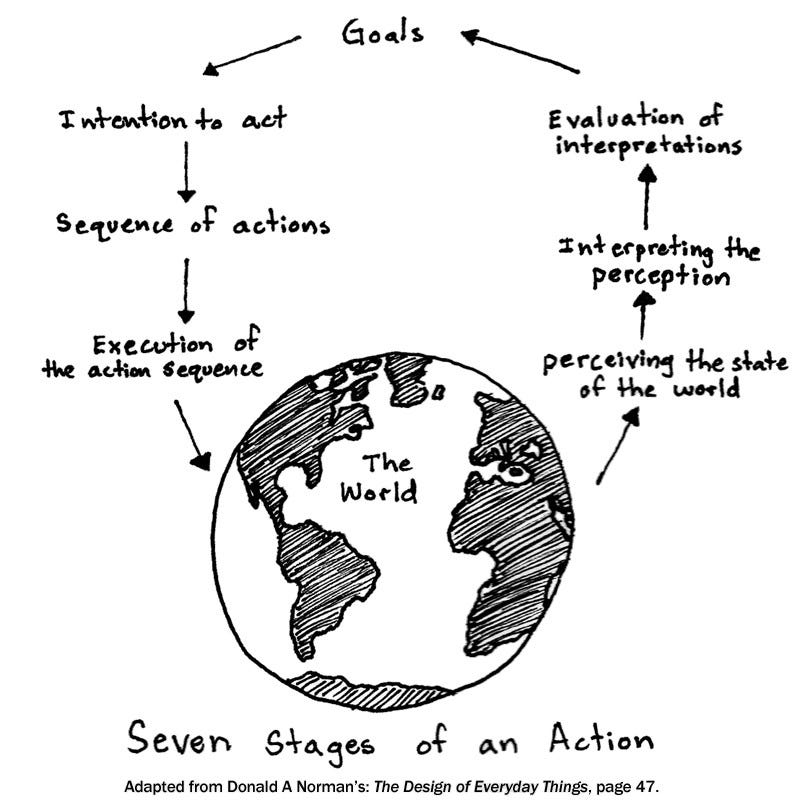What is the Design of Everyday Things?
Design is about the art and science of making things — including products, services, and spaces such as buildings and cities.
Design is everywhere. From a digital product to a physical product. Heck, even a service or a person’s personality.
This book will remind you how difficult it was for you to use some of the trivial objects that most people use daily. It was opening and closing the pressure cooker lid for me.
I used to bunk at my sister's house back when I was in college. She had to get ready for work in the morning, so she put some gravy and rice in the cooker.
Now, at lunchtime, I went to the kitchen to remove the rice from the cooker, but I couldn't get the lid to open! I struggled with it for the next 30 minutes. After failing to open the lid completely, I eventually managed to open a small gap, allowing me to remove less than a handful of rice and get me through my lunchtime. Later that day, my sister noticed that more than 80% of the rice was still in the cooker and inquired why I hadn't eaten any. I told her about my lunchtime misery, and she burst out laughing. (Now everyone in my family knows I can't open the pressure cooker lid.)
But thanks to this book by Don Norman, I can blame my embarrassment entirely on Denis Papin (Inventor of Pressure Cooker).
Don Norman discusses how, in most cases, a lack of sensible design complicates even the most basic activities in his book Design Of Everyday Things.
You'll eventually notice that a good design is more than just aesthetics. Even if a product or a service is beautifully designed, it can still have significant flaws due to poor user experience or functionality.

Don Norman introduces product design from five key aspects, here’s my attempt to explain these concepts in the simplest manner:
1. How do products interact with the Users
Product interacts with users through seven touchpoints:
Affordance
The best line to describe affordances would be ‘Don’t make me think, stupid’ (title of the book written by Steve Krug)
Affordances are clues embedded in an object which eliminates any sort of guesswork. For example, when you see a coffee mug, you don’t really need instruction to understand how to hold it. This term originated from Ecological psychology(proposed by James Gibson) to denote possible actions provided to the actor by the environment.
You can find affordances in objects in your everyday life, these are actions you perform on objects without consciously thinking about them like — unlocking your phone or opening a book to read.
On the other hand, we are surrounded by objects that have poor affordances, such as doors without Pull/Push labels or pressure cookers (as you already know, I do hold a grudge against them). Anything that requires you to think for more than a second; frequently indicates that there is some friction between expectation and reality, which is a strong indicator of poor affordance.
Signifier
Now that we have some sense of what affordance means, we can better understand signifiers
In the simplest of terms, signifiers are affordances with labels.
Your brain can instantly recognize that a user interface has a button thanks to affordance, but signifiers tell you what that button is supposed to do through text or an icon. When you notice a button is active or inactive, you can visually represent the signifier.
Constraints
When I was researching AI, I came across some basic concepts that I thought made a lot of psychological sense in terms of how a human and animals respond to a situation in a particular way. It's similar to the carrot and stick method of behavioral training. You train a dog by rewarding it for specific behavior so that its brain learns what they need to do to be rewarded – AI, humans, and animals all work in the same manner.
Applying the same principles in design, we often need to guide a customer to make certain decisions, whether to follow a particular workflow or purchase a particular item.
Mappings
Mapping is an analogical relationship between the controls and the devices being controlled. Have you seen an airplane’s or a rocket’s cockpit?
Too complicated? Well, it is! and pilots are trained for months to learn the nitty-gritty of the cockpit such that it becomes second nature to them even before their first flight. They practice by creating sequences and patterns that they may need in various scenarios, similar to how you may go to Amazon and get any things you want. Not just because the activity is repetitive, but also because of the way the user experience mapping is described on the page, you can do so.
Feedback
Remember playing poker? You try to read your opponent's face and mind, trying to figure out their 'tell' so you can decide whether to call, raise, or fold. What you're aiming to accomplish here is acquire input from your opponent and make the best decision possible based on how well you can receive it.
In digital products, feedback is the language through which a screen communicates back to us.
Conceptual Model
Conceptual models are abstract, psychological representations of how tasks should be carried out.
Applying the Affordances, Signifiers, Constraints, Mapping, and Feedback in product’s development, we create a conceptual model of how that product is supposed to work and where it is supposed to work.
Imagine, seeing a microwave in the bathroom or streaming a stand-up comedy show on the News channel — Sounds absurd right?
We must build a good context for every product we make, and the context should be pre-existing the majority of the time.
“Everyone understands the need for change in the abstract, but people are creatures of habit. Too much innovation is traumatic, and will lead to revolt…respect the old way of doing things. If change is necessary, make it feel like a gentle improvement on the past.” — Robert Greene
Conceptual models are typically recognized at the start of the design process and used as a source of inspiration and direction throughout.
2. How do people do things?
Whenever we view any product whether that is a website, app, or a book — in our mind we always create a mental set of actions of what is needed to be done to utilize that product.
One of the topics that Donald Norman discusses in this book, is the model of how people interact with the real world. This model is called the seven stages of action, or Norman’s action cycle.
Forming a Goal
I can’t read my book because the room is dimly lit. I need more light in order to read my book.
Intention to Act
There is a light next to my chair. Turning on the light would allow me to read my book.
Planning the Action
I need to reach over and turn on the light.
Executing the Action
I reach over to turn on the light.
Feedback from the Action
The light turns on.
Interpret the Feedback
I am now able to see the text and can read my book.
Evaluate the Outcome
Positive — I’m able to read my book. No further action is needed.
Negative — The light doesn’t work. The Action Cycle is either repeated or a new goal is formed.
In terms of human-computer interaction, a well-designed product should allow a user to complete the Action Cycle without experiencing any friction. if the outcome is pain and frustration, then the user is obliged to repeat the task Cycle several times for a single action.
Gulf of Execution and Evaluation
In this book, Don Norman presents two new ideas to address the problem of design failings to meet user expectations: “Gulf of Execution” and “Gulf of Evaluation.”
Gulf of Execution
He expresses Gulf of Execution as a situation when a user is having trouble deciding how to accomplish a task.
Let’s say a user is trying to buy anything from an online retailer. She comes upon an item she wants to buy and adds it to her shopping basket. Unfortunately, there appears to be no interface element (e.g., a button, icon, checkbox, etc.) that will allow her to add the item to her cart. Having an online store where consumers have trouble adding things to their shopping cart is a user interface failure, and it is damaging to the company’s purpose of selling products
Gulf of Evaluation
When a user has problems evaluating a feature or performing the intended action, the Gulf of Evaluation occurs. Simply put, the user expects feedback from the activity, and if it does not meet their expectations, the user's overall experience is affected. Consider the following scenario:
Add an item to your online shopping cart
Press the “Checkout” button
Wait …
Press the “Checkout” button again
Wait again …
Begin to scan the page to see if anything is happening …
The user experiences pain and frustration
The system has failed
Don Norman is all about fine-tuning, so the product is easy to use and gives the user clear results. This is a short checklist for designers to make sure there isn't too much of a performance gap that forces the user to think too much and diverts them from their intended activity. Norman criticizes traditional linear design processes in favor of iterative design.
4. Design Thinking
One of my rules in consulting is simple: never solve the problem I am asked to solve…because, invariably, the problem I am asked to solve is not the real, fundamental, root problem. It is usually a symptom.
The way our minds are wired, we tend to solve the problem that is in front of us, ignoring the core cause. Instead of only tackling the problems we see on the surface, we should make it a habit to understand "why" any problem occurs.
To train ourselves to approach any problem in the right fashion, Norman introduces us to the Double Diamond Model of Design. Two phases to this model are:
Finding the right problem: This is where we undertake research to discover and characterize the difficulties, followed by an analysis of significant insights. This will assist us in narrowing down a broad problem to a specific one.
Finding the right solution: After we've identified the true problem we're trying to tackle, we'll need to come up with a hypothesis, develop a solution, and create a prototype to evaluate the solution's practicality.
Initial study leads to the exploration of the root difficulties in each phase. We should prioritize and focus on solving the most significant challenge after we have a large number of problem statements and ideas.
Use the Human Centred Design(or spiral method) to iterate the discussion in the double-diamond model:
Observation
Wander around the process. Understand how the puzzle pieces fit together, as well as the motivations of the users and their genuine demands. Look for important intersections.
“Customer research is a tradeoff: deep insights on real needs from a small set of people, versus broad, reliable purchasing data from a wide range and a large number of people. We need both.”
Idea generation
Based on your Observation, list down each and every idea that you can think of. Be creative without regard for constraints. Even crazy ideas can contain interesting insights that can be repurposed or incorporated into other ideas.
Question everything. Stupid questions are absolutely okay. Upend your assumptions. Be critical of the status quo. The obvious is rarely so, always dive deeper.
Prototyping
Find the easiest and fasted way to portray your ideas. Start with low-fidelity prototypes by using pen-paper or simple slides.
The goal should showcase that main utility that you are trying to solve.
“Prototyping during the problem specification phase is done mainly to ensure that the problem is well understood. If the target population is already using something related to the new product, that can be considered a prototype. During the problem solution phase of design, then real prototypes of the proposed solution are invoked.”
Testing
Validation is the process by which a product team puts its prototypes to the test with real users. Testing your prototype will assist you in bridging the gap between what people claim they need and what they actually require.
To practise HCD, you should aim to answer the following questions when reviewing prototypes:
Is the product useful and usable (does it solve a real problem/usability)?
Does the product look good (look)?
Do users enjoy using it (feel)?
Iteration
In Human Centred Design, iteration is the repetition of the observe-generate-prototype-test cycle in order to refine and enhance a product or service.
In some cases, you can iterate through parts of the cycle. For instance: repeated iterations of study and testing to determine which parts of the design work and which don’t.
Deliberate tests and modifications result in product improvements.
Iterative failures should be viewed as learning experiences.
“If everything works perfectly, little is learned. Learning occurs when there are difficulties.”
5. Design and Business
Norman here describes the marriage between the business and product designs. UI/ UX plays an immense role in the success of any business.
UI/UX is the language used by the product to interact with the customer
Key competitive dimensions in which every company factors are Price, Features, Quality, and also Speed.
In the final chapter, Norman talks about a deadly virus called Featuritis
Featuritis
aka “feature creep”, is the phenomenon when a successful product adds new features and capabilities to the point that it overcomplicates and muddles what was once a simple, rich, and easy solution.

Major factors that contribute to feature creep:
Existing stakeholders need more elements, usefulness, and capacities.
Competition causes pressure on companies to release new features
The market is saturated or stagnant. Adding new enhancements will boost the upgrade cycle.
“The best products come from ignoring these competing voices and instead focusing on the true needs of the people who use the product.”
Finals Thoughts
"The design of everyday things" is a book that is simple to read and comprehend. The principles described in the book apply to a wide range of disciplines and will help you make better decisions when building products and services. The principles presented by the author in this book apply not only to design but to life in general. It is a great way for people to better understand their surroundings and learn from the mistakes made by others. I highly recommend this book for anyone who is involved in the user experience design process, but I also think it’s a must-read for any creator who is getting started or those who want to improve their skills.
Do comment your opinion on the book and this blog. I would love to read and go through it.
Finally, feel free to suggest any other book that you find interesting that and would want me to write about it.
👋🏻 Hey there, Want to talk about Product Management, Self-help Books, Music or Football?
Feel free to reach out to me on any of the social media platforms:
Twitter — https://twitter.com/and_its_praneet
Insta — https://www.instagram.com/theone_whoplays/
LinkedIn — https://www.linkedin.com/in/praneet-sinha/
















Hey, I have also read this book and found it amazing. Loved your illustrations.